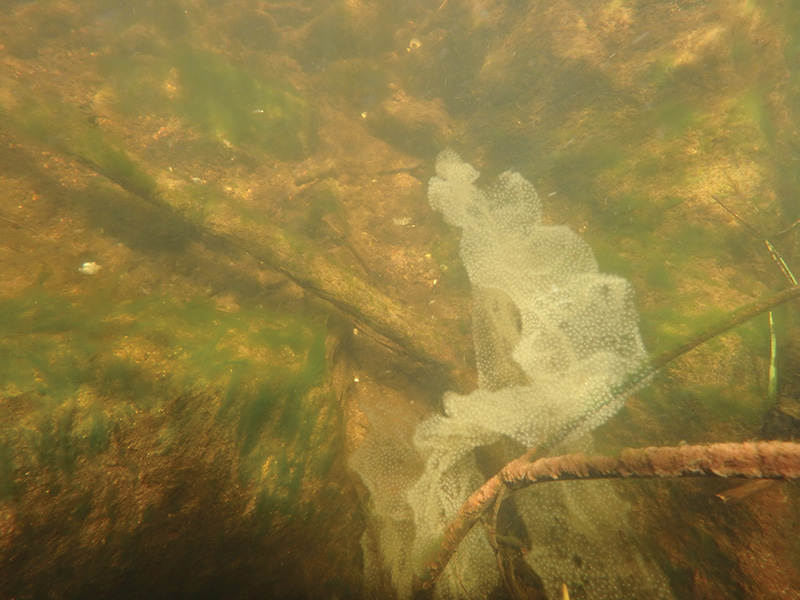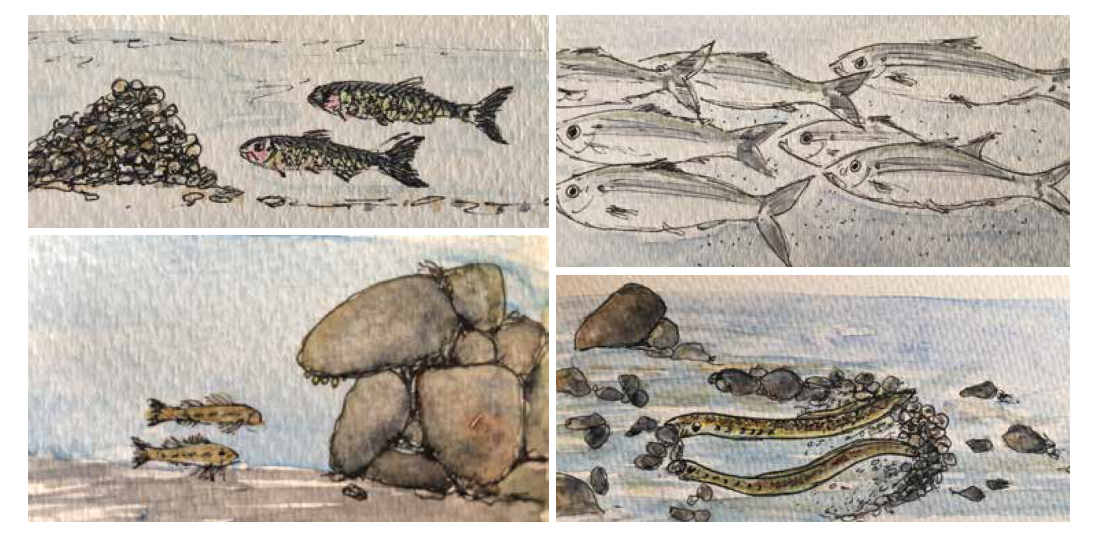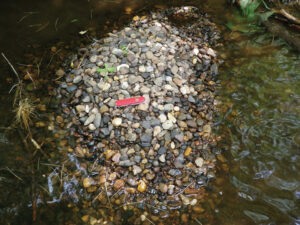 This article appears in the Summer 2024 issue
This article appears in the Summer 2024 issue

Spawning Below the Surface
By Steve Gephard and Sally Harold

Yellow Perch eggs are encased in long gelatinous strands that get hung up on branches and aquatic vegetation. Image Credit: Steve Gephard.
As our days grow longer in the Connecticut River watershed, many a young fish’s fancy turns to love. These spawning fish have unique ways of reproducing. “Spawn” can be a verb that refers to how fish reproduce or breed, and it can also be a noun referring to the reproductive products of the fish, i.e. eggs and sperm (or “milt,” as fish sperm is often called). A vast majority of fish species spawn by external fertilization, which means that the eggs are fertilized outside of the female’s body and the fertilized eggs are left in the natural environment to develop. There are some species, including some sharks, that use internal fertilization, and live offspring issue from the mother’s body (are born). For this article, we will concentrate on the common species in our river that are hatched, not born.
The timing of spawning has evolved for each species based on their life history. Typical New England weather results in the Connecticut River having the highest flows during the spring (April–June) and quite low flows during the summer. The low summer flows impede effective migration, especially to the upper portion of the watershed and likely make the mouth of the river less discoverable to fish in the ocean. Therefore, most of our anadromous fish like salmon, shad, and river herring have springtime spawning migrations. For shad and river herring, whose young will need to depart for the ocean before the waters turn cold in the winter, springtime spawning gives the young enough time to feed and grow over the summer in freshwater to a size suitable for oceanic migration. (They’ll leave our streams for saltwater in the fall.) In contrast, many of the Pacific salmon migrations in Alaska and the Northwest are summer migrations because those rivers are fed by glacial melt, and it is during the summer when the flows are the most reliable.
Most members of the salmon and trout family, including Atlantic salmon, brook trout, and brown trout, have a different schedule for spawning. These species need cold water for their slowly developing eggs. These eggs would not survive during a hot New England summer; therefore, they spawn in the fall, and the eggs incubate all winter long. If the eggs hatched in the winter, the fry would surely starve because there would not be enough aquatic insects to feed upon. When they hatch in April and May there are many bugs to eat. Eggs lying in a stream all winter long could be very vulnerable to predation or physical destruction, but as we’ll see, these fish have evolved a way to protect them.
Eggs are full of nutrients and are an attractive food for many other species. Fish use a variety of strategies to ensure sufficient numbers of eggs avoid being eaten to create the next generation. For example, an alewife may produce 150,000 eggs that are very small and transparent. The adult fish spawn in schools and one night of spawning will release millions of eggs. These fish accept the philosophy of “they can’t eat them all” and offer no further parental protection after release. An Atlantic salmon may only produce 6,000 eggs, and they are relatively large and orange, easy to see. They bury their eggs under gravel to hide them from predators and protect them from the winter’s ice and floods.
The spawning habits of our fish can be put into one of two categories: nest-builders or broadcasters. The nest-builders create a variety of nest types to protect their eggs while the broadcasters (like the alewife) simply exude clouds of eggs and milt into the water where fertilization occurs and from that point, the developing eggs are on their own. Often groups of spawning shad and river herring are accompanied by schools of spottail shiners, trout, and catfish that nab as many of the eggs as they can. Some broadcasted eggs (like those of shad) drift in the water current for several days before hatching into larvae. For this reason, shad do not spawn downstream of Middletown, Connecticut, because from there, eggs could drift into brackish or saltwater and die. Other broadcasted eggs (like those of blueback herring) are adhesive and may adhere to rocks and vegetation and stay put. Sometimes we’ve emerged from snorkeling among spawning Bluebacks and found our wetsuits coated with these sticky eggs.

Upper Left: Male fallfish use their mouths to pick up pebbles from the streambed and build conical piles over which the males and females spawn.
Upper Right: Male and female blueback herring swim frenetically in schools, releasing eggs and milt into flowing water.
Lower Right: Male and female sea lamprey use their sucker-like mouths to drag stones from a circular area of streambed back to a crescent-shaped pile of rocks downstream.
Lower Left: Female tesselated darters deposit one sticky egg at a time under a rock edge where the male fertilizes them. Images Credit: Sally Harold (drawings).
Nest builders can be further divided into those that parent and those that don’t. In the case of spawning salmon and trout, they bury their eggs and depart. The adults are long gone when the eggs hatch, and the fry (tiny juveniles) wiggle up through the gravel the following spring. Sunfish (including largemouth and smallmouth bass, which, technically are sunfish) clear a circular area of pond or stream bottom (out of the current), lay their eggs on top of the sand or pebble bottom, and do not bury the eggs. The parents stay with the nest and chase away fish, like minnows, that try to dart in and gobble up eggs. At some point after the eggs hatch, the parents drift away. Another type of fish nest is the rock pile. The parents don’t bury the eggs but release them above or upstream of the rock pile, and the eggs wash down into the gaps between the rocks where they incubate, protected from most predators. One species that can penetrate that line of defense is the American eel. Small elvers can wiggle through the rocks and reach those gaps where the eggs are entombed.

This fallfish nest in Connecticut’s Jeremy River was likely constructed by many male fallfish. The nest is completely underwater in the spring when the fish spawn. Image Credit: Steve Gephard.
Two species that use the rock pile approach are sea lamprey and fallfish. The sea lamprey creates a rock pile nest by removing rocks from an area of streambed in a fast-flowing section of stream using their sucker-like mouths to drag stones backwards and deposit them in a mound. That creates a pit where the male and female attach to upstream rocks and spawn so the eggs are washed downstream into the rock pile. Soon after spawning, both parents die. Fallfish, a species of native minnow that can vary in length from five to fifteen inches, use their mouths to create a pyramid-shaped pile of small stones. The parents spawn over the pile and let their eggs trickle down into the gaps between the stones. The nests are not used by just two fish, but likely an entire local community of fallfish. Parents hover around the nest, protecting the developing eggs for an extended period. These nests are built in areas with slow current and can persist for many years, expanded, and reused year after year. Some nests are so large the small stones could fill multiple wheelbarrows.
Perhaps some species could belong to a third category. They don’t build nests, but neither do they indiscriminately broadcast their eggs. Early in the spring, yellow perch exude long strands of ribbon-like eggs onto submerged vegetation, which holds the eggs in place until they hatch. The small and often overlooked tesselated darter will exude one sticky egg at a time and fasten it to the underside of a rock, exposed but hopefully unseen. Such a technique requires lots of clean jumbles of cobbles and rocks with many crevices and gaps for the darter to penetrate. Heavily sanded or silted streambeds can fill these nooks and crannies and eliminate darter spawning habitat. Excessive fine sediment in streams is an obstacle for most nest-building species, particularly species like salmon and trout that bury their eggs. Their survival depends on the eggs being bathed in well-oxygenated water flowing through the rocks. If the streambed is heavily sanded, the water (and the oxygen) cannot penetrate, and the eggs suffocate. One more reason to take good care of our streams.
Steve Gephard supervised Connecticut’s participation in the Connecticut River Atlantic Salmon Restoration during his long career as a fish biologist with the Connecticut Fisheries Division. He continues to serve as a US Commissioner to the North Atlantic Salmon Conservation Organization.
Sally Harold worked on dam removal projects that benefited salmon restoration when she worked with The Nature Conservancy.
